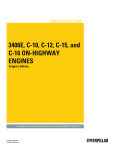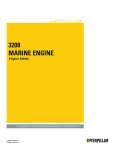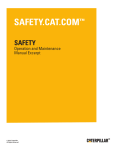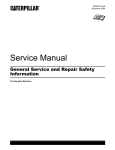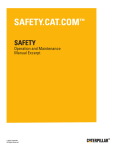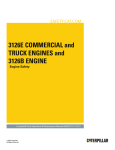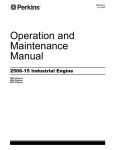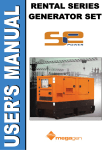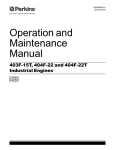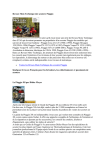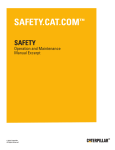Download XQ125 Rental Generator Sets - Safety
Transcript
SAFETY Operation and Maintenance Manual Excerpt © 2010 Caterpillar All Rights Reserved ® ® SEBU6617-04 April 2001 Operation and Maintenance Manual XQ125 Rental Generator Sets DED1-Up (Generator Set) 9HK1-Up (Engine) This Manual Must be Accessible at the Point of Operation i01097883 Important Safety Information Most accidents that involve product operation, maintenance and repair are caused by failure to observe basic safety rules or precautions. An accident can often be avoided by recognizing potentially hazardous situations before an accident occurs. A person must be alert to potential hazards. This person should also have the necessary training, skills and tools to perform these functions properly. Improper operation, lubrication, maintenance or repair of this product can be dangerous and could result in injury or death. Do not operate or perform any lubrication, maintenance or repair on this product, until you have read and understood the operation, lubrication, maintenance and repair information. Safety precautions and warnings are provided in this manual and on the product. If these hazard warnings are not heeded, bodily injury or death could occur to you or to other persons. The hazards are identified by the “Safety Alert Symbol” and followed by a “Signal Word” such as “DANGER”, “WARNING” or “CAUTION”. The Safety Alert “WARNING” label is shown below. The meaning of this safety alert symbol is as follows: Attention! Become Alert! Your Safety is Involved. The message that appears under the warning explains the hazard and can be either written or pictorially presented. Operations that may cause product damage are identified by “NOTICE” labels on the product and in this publication. Caterpillar cannot anticipate every possible circumstance that might involve a potential hazard. The warnings in this publication and on the product are, therefore, not all inclusive. If a tool, procedure, work method or operating technique that is not specifically recommended by Caterpillar is used, you must satisfy yourself that it is safe for you and for others. You should also ensure that the product will not be damaged or be made unsafe by the operation, lubrication, maintenance or repair procedures that you choose. The information, specifications, and illustrations in this publication are on the basis of information that was available at the time that the publication was written. The specifications, torques, pressures, measurements, adjustments, illustrations, and other items can change at any time. These changes can affect the service that is given to the product. Obtain the complete and most current information before you start any job. Caterpillar dealers have the most current information available. For a list of the most current publication form numbers available, see the Service Manual Contents Microfiche, REG1139F. When replacement parts are required for this product Caterpillar recommends using Caterpillar replacement parts or parts with equivalent specifications including, but not limited to, physical dimensions, type, strength and material. Failure to heed this warning can lead to premature failures, product damage, personal injury or death. 6 Safety Section Safety Signs and Labels Batteries Safety Section i01474798 Safety Signs and Labels SMCS Code: 1000; 7405 There may be several specific safety signs on the generator set package. The exact location of the hazards and the description of the hazards are reviewed in this section. Please become familiar with all safety signs. Ensure that all of the safety signs are legible. Clean the safety signs or replace the safety signs if the words cannot be read or if the pictures are not visible. When the safety signs are cleaned, use a cloth, water, and soap. Do not use solvent, gasoline, or other harsh chemicals to clean the safety signs. Solvents, gasoline, or harsh chemicals could loosen the adhesive that secures the safety signs. The safety signs that are loosened could drop off of the generator set package. Replace any damaged safety signs or missing safety signs. If a safety sign is attached to a part of the generator set package that is replaced, install a new safety sign on the replacement part. Any Caterpillar dealer can provide new safety signs. Do not operate or work on this engine unless you have read and understand the instructions and warnings in the Operation and Maintenance Manual. Failure to follow the instructions or heed the warnings could result in injury or death. Contact any Caterpillar dealer for replacement manuals. Proper care is your responsibility. The warning labels that may be found on the generator set package are illustrated and described. Illustration 1 g00769127 (1) Battery compartment (2) Battery The warning label for the battery is located in the battery compartment above the battery disconnect switch. The warning label for the batteries is located in the lower left hand corner of the top of the battery. g00455028 7 Safety Section Safety Signs and Labels Electrical Distribution (Generator) Improper jumper cable connections can cause explosion resulting in personal injury. Batteries may be located in separate compartments. When using jumper cables, always connect positive (+) cable to positive (+) terminal of battery connected to starter solenoid and negative (−) cable from external source to starter negative (−) terminal (if machine not equipped with starter negative terminal, connect to engine block.) Follow procedure in the operation manual. Operation Of Package Illustration 3 g00769114 The warning label for the electrical distribution (generator) is located in two places. One warning label for electrical distribution (generator) is located on the barrel of the generator. The other warning label for electrical distribution (generator) is located on the clear plastic cover which covers the distribution panel. Illustration 2 g00769112 The warning label for the operation of package is located on the rear of the enclosure. g00296980 Do not connect generator to a utility electrical distribution system unless it is isolated from the system. Electrical feedback into the distribution system can occur and could cause personal injury or death. g00769113 Do not operate, tow or work on this unit unless you have read and understand the instructions and warnings in the operation and maintenance manuals. Failure to follow the warnings and instructions could result in injury or death. Contact any Caterpillar dealer for replacement manuals. Proper care is your responsibility. Open and secure main distribution system switch, or if the connection is permanent, install a double throw transfer switch to prevent electrical feedback. Some generators are specifically approved by a utility to run in parallel with the distribution system and isolation may not be required. Always check with your utility as to the applicable circumstances. 8 Safety Section Safety Signs and Labels Trailer Illustration 4 Trailer Towing g00769118 The warning label for the trailer is located at the front of the trailer on the tongue assembly. Illustration 5 g00769122 The warning label for towing the trailer is located on the front of the tongue jack. g00769121 g00769123 Do not uncouple the trailer from the towing vehicle until the wheels are securely blocked or chocked. Failure to do so could result in injury. Failure to utilize an appropriate and properly sized tow vehicle with a level-horizontal hitch connection could lead to excessive towing sway resulting in personal injury or death. Before towing inspect the coupling devices and check the torque on the tongue retaining bolts. Required torque is 370 ± 50 N·m (273 ± 37 lb ft). For trailer with adjustable hitch, inspect the torque on the hitch bolts. Required torque is 215 ± 40 N·m (159 ± 30 lb ft). 9 Safety Section General Hazard Information Overload i01483307 General Hazard Information SMCS Code: 1000; 7405 Illustration 6 g00769125 The warning label for overload is located on the front panel of the unit. Illustration 7 g00104545 Attach a “Do Not Operate” warning tag or a similar warning tag to the start switch or to the controls before the engine is serviced or before the engine is repaired. These warning tags (Special Instruction, SEHS7332) are available from your Caterpillar dealer. Attach the warning tags to the engine and to each operator control station. When it is appropriate, disconnect the starting controls. Do not allow unauthorized personnel on the engine, or around the engine when the engine is being serviced. g00771823 Engine exhaust contains products of combustion which may be harmful to your health. Always start the engine and operate the engine in a well ventilated area. If the engine is in an enclosed area, vent the engine exhaust to the outside. 1. Gross weight of the trailer is 5670 kg (12500 lb) (wet) and 4853 kg (10700 lb) (dry without fuel). Cautiously remove the following parts. To help prevent spraying or splashing of pressurized fluids, hold a rag over the part that is being removed. DO NOT OVERLOAD Hitch weight is: 567 kg (1250 lb) (wet) and 485 kg (1070 lb) (dry). Do not under any circumstances tow with a vehicle rated for less than the gross weight of this trailer. (See your truck owners manual for towing capacity.) • Filler caps • Grease fittings • Pressure taps • Breathers 2. Trailer MUST BE LEVEL when towed. If you cannot make adjustments in the hitch to make it level, use a different towing vehicle. Violating either of these recommendations could make the trailer unstable and could result in injury or death. • Drain plugs Use caution when cover plates are removed. Gradually loosen, but do not remove the last two bolts or nuts that are located at opposite ends of the cover plate or the device. Before removing the last two bolts or nuts, pry the cover loose in order to relieve any spring pressure or other pressure that may be present. 10 Safety Section General Hazard Information • After repairs have been made to the fuel system or repairs have been made to the governor, make provisions to shut off the air supply and the fuel supply to the engine in order to stop the engine in case there is an overspeed upon start-up. • Always start the engine from the operator’s station. Never short across the starter terminals or the batteries. The engine neutral start system and/or the electrical system could be damaged. • Never start the engine when the governor linkage is disconnected. Illustration 8 g00702020 • Wear a hard hat, protective glasses, and other protective equipment, as required. • When work is performed around an engine that is operating, wear protective devices for ears in order to help prevent damage to hearing. • Do not wear loose clothing or jewelry that can snag on controls or on other parts of the engine. • Ensure that all protective guards and all covers are secured in place on the engine. • Never put maintenance fluids into glass containers. Glass containers can break. Pressure Air and Water Pressurized air and/or water that is used for cleaning can cause debris and/or hot water to be blown out. This could result in personal injury. When pressure air and/or pressure water is used for cleaning, wear protective clothing, protective shoes, and eye protection. Eye protection includes goggles or a protective face shield. The maximum air pressure for cleaning purposes should be below 205 kPa (30 psi). The maximum water pressure for cleaning purposes should be below 275 kPa (40 psi). Fluid Penetration • Use all cleaning solutions with care. • Report all necessary repairs. Unless other instructions are provided, perform the maintenance under the following conditions: • The engine is stopped. Ensure that the engine cannot be started. • Ensure that the protective locks or controls are in the applied position. • Disconnect the batteries when maintenance is performed or when the electrical system is serviced. Disconnect the battery ground leads. Tape the leads in order to help prevent sparks. • Do not attempt any repairs that are not understood. Use the proper tools. Replace any equipment that is damaged or repair the equipment. This unit creates vacuum during operation capable of closing doors if not secured. Use door tie backs and rods to avoid personal injury. Illustration 9 g00687600 Always use a board or cardboard when you check for a leak. Leaking fluid that is under pressure can penetrate body tissue. Fluid penetration can cause serious injury and possible death. A pin hole leak can cause severe injury. If fluid is injected into your skin, you must get treatment immediately. Seek treatment from a doctor that is familiar with this type of injury. 11 Safety Section General Hazard Information Containing Fluid Spillage This unit is equipped with a fluid spill containment basin. The fluid spill containment basin is capable of containing the entire volume of engine oil and coolant. The fluid spill containment basin is also capable of containing a reasonable overflow of the fuel tank. These fluids must be absorbed and collected for proper disposal. This unit is equipped with fluid containment basins on both sides of the base for the fuel tank. These fluid containment basins normally collect water that is drawn in through the fresh air intakes of the package. The fluid containment basins are equipped with drain valves. Fluids that are drained from the fluid containment basins should be disposed of properly. Caterpillar equipment and replacement parts that are shipped from Caterpillar are asbestos free. Caterpillar recommends the use of only genuine Caterpillar replacement parts. Use the following guidelines when you handle any replacement parts that contain asbestos or when you handle asbestos debris. Use caution. Avoid inhaling dust that might be generated when you handle components that contain asbestos fibers. Inhaling this dust can be hazardous to your health. The components that may contain asbestos fibers are brake pads, brake bands, lining material, clutch plates, and some gaskets. The asbestos that is used in these components is usually bound in a resin or sealed in some way. Normal handling is not hazardous unless airborne dust that contains asbestos is generated. Care must be taken in order to ensure that fluids are contained during performance of inspection, maintenance, testing, adjusting and repair of the engine. Prepare to collect the fluid with suitable containers before opening any compartment or disassembling any component containing fluids. If dust that may contain asbestos is present, there are several guidelines that should be followed: Refer to Special Publication, NENG2500, “Tools and Shop Products Guide” for the following items: • Use a wet method in order to clean up asbestos • Tools that are suitable for collecting fluids and • A vacuum cleaner that is equipped with a high equipment that is suitable for collecting fluids • Tools that are suitable for containing fluids and equipment that is suitable for containing fluids • Avoid brushing materials that contain asbestos. • Avoid grinding materials that contain asbestos. materials. efficiency particulate air filter (HEPA) can also be used. • Use exhaust ventilation on permanent machining jobs. Obey all local regulations for the disposal of liquids. • Wear an approved respirator if there is no other way to control the dust. Asbestos Information • Comply with applicable rules and regulations for the work place. In the United States, use Occupational Safety and Health Administration (OSHA) requirements. These OSHA requirements can be found in “29 CFR 1910.1001”. • Obey environmental regulations for the disposal of asbestos. • Stay away from areas that might have asbestos particles in the air. Illustration 10 g00702022 12 Safety Section Burn Prevention Dispose of Waste Properly Cooling system conditioner contains alkali. Alkali can cause personal injury. Do not allow alkali to contact the skin, the eyes, or the mouth. Oils Hot oil and hot lubricating components can cause personal injury. Do not allow hot oil to contact the skin. Also, do not allow hot components to contact the skin. Batteries Illustration 11 g00706404 Improperly disposing of waste can threaten the environment. Potentially harmful fluids should be disposed of according to local regulations. Always use leakproof containers when you drain fluids. Do not pour waste onto the ground, down a drain, or into any source of water. i01480768 Electrolyte is an acid. Electrolyte can cause personal injury. Do not allow electrolyte to contact the skin or the eyes. Always wear protective glasses for servicing batteries. Wash hands after touching the batteries and connectors. Use of gloves is recommended. i01496776 Fire Prevention and Explosion Prevention SMCS Code: 1000; 7405 Burn Prevention SMCS Code: 1000; 7405 Do not touch any part of an operating engine. Allow the engine to cool before any maintenance is performed on the engine. Relieve all pressure in the air system, in the hydraulic system, in the lubrication system, in the fuel system, or in the cooling system before any lines, fittings or related items are disconnected. Coolant g00704000 When the engine is at operating temperature, the engine coolant is hot. The coolant is also under pressure. The radiator and all lines to the heaters or to the engine contain hot coolant. Illustration 12 Any contact with hot coolant or with steam can cause severe burns. Allow cooling system components to cool before the cooling system is drained. Flammable fluids that are leaking or spilled onto hot surfaces or onto electrical components can cause a fire. Fire may cause personal injury and property damage. Check the coolant level after the engine has stopped and the engine has been allowed to cool. A flash fire may result if the covers for the engine crankcase are removed within fifteen minutes after an emergency shutdown. Ensure that the filler cap is cool before removing the filler cap. The filler cap must be cool enough to touch with a bare hand. Remove the filler cap slowly in order to relieve pressure. All fuels, most lubricants, and some coolant mixtures are flammable. Determine whether the engine will be operated in an environment that allows combustible gases to be drawn into the air inlet system. These gases could cause the engine to overspeed. Personal injury, property damage, or engine damage could result. 13 Safety Section Fire Prevention and Explosion Prevention If the application involves the presence of combustible gases, consult your Caterpillar dealer for additional information about suitable protection devices. Remove all flammable materials such as fuel, oil, and debris from the engine. Do not allow any flammable materials to accumulate on the engine. All fluids that are captured in the fluid spill containment basin should be cleaned up immediately. Failure to clean up spilled fluids can cause a fire. Fire may cause personal injury and property damage. Store fuels and lubricants in properly marked containers away from unauthorized persons. Store oily rags and any flammable materials in protective containers. Do not smoke in areas that are used for storing flammable materials. Do not expose the engine to any flame. Illustration 13 Exhaust shields (if equipped) protect hot exhaust components from oil or fuel spray in case of a line, a tube, or a seal failure. Exhaust shields must be installed correctly. Use caution when you are refueling an engine. Do not smoke while you are refueling an engine. Do not refuel an engine near open flames or sparks. Always stop the engine before refueling. g00704059 Do not weld on lines or tanks that contain flammable fluids. Do not flame cut lines or tanks that contain flammable fluid. Clean any such lines or tanks thoroughly with a nonflammable solvent prior to welding or flame cutting. Wiring must be kept in good condition. All electrical wires must be properly routed and securely attached. Check all electrical wires daily. Repair any wires that are loose or frayed before you operate the engine. Clean all electrical connections and tighten all electrical connections. Eliminate all wiring that is unattached or unnecessary. Do not use any wires or cables that are smaller than the recommended gauge. Do not bypass any fuses and/or circuit breakers. Arcing or sparking could cause a fire. Secure connections, recommended wiring, and properly maintained battery cables will help to prevent arcing or sparking. Inspect all lines and hoses for wear or for deterioration. The hoses must be properly routed. The lines and hoses must have adequate support and secure clamps. Tighten all connections to the recommended torque. Leaks can cause fires. Oil filters and fuel filters must be properly installed. The filter housings must be tightened to the proper torque. Illustration 14 g00704135 Gases from a battery can explode. Keep any open flames or sparks away from the top of a battery. Do not smoke in battery charging areas. Never check the battery charge by placing a metal object across the terminal posts. Use a voltmeter or a hydrometer. 14 Safety Section Crushing Prevention and Cutting Prevention Improper jumper cable connections can cause an explosion that can result in injury. Refer to the Operation Section of this manual for specific instructions. • End fittings are damaged or leaking. • Outer coverings are chafed or cut. • Wires are exposed. Do not charge a frozen battery. This may cause an explosion. The batteries must be kept clean. The covers (if equipped) must be kept on the cells. Use the recommended cables, connections, and battery box covers when the engine is operated. • Outer coverings are ballooning. • Flexible part of the hoses are kinked. • Outer covers have embedded armoring. • End fittings are displaced. Fire Extinguisher Make sure that a fire extinguisher is available. Be familiar with the operation of the fire extinguisher. Inspect the fire extinguisher and service the fire extinguisher regularly. Obey the recommendations on the instruction plate. Ether Make sure that all clamps, guards, and heat shields are installed correctly. During engine operation, this will help to prevent vibration, rubbing against other parts, and excessive heat. i01359666 Crushing Prevention and Cutting Prevention Ether is flammable and poisonous. SMCS Code: 1000; 7405 Use ether in well ventilated areas. Do not smoke while you are replacing an ether cylinder or while you are using an ether spray. Do not store ether cylinders in living areas or in the engine compartment. Do not store ether cylinders in direct sunlight or in temperatures above 49 C (120 F). Keep ether cylinders away from open flames or sparks. Dispose of used ether cylinders properly. Do not puncture an ether cylinder. Keep ether cylinders away from unauthorized personnel. Do not spray ether into an engine if the engine is equipped with a thermal starting aid for cold weather starting. Lines, Tubes and Hoses Do not bend high pressure lines. Do not strike high pressure lines. Do not install any lines that are bent or damaged. Support the component properly when work beneath the component is performed. Unless other maintenance instructions are provided, never attempt adjustments while the engine is running. Stay clear of all rotating parts and of all moving parts. Leave the guards in place until maintenance is performed. After the maintenance is performed, reinstall the guards. Keep objects away from moving fan blades. The fan blades will throw objects or cut objects. When objects are struck, wear protective glasses in order to avoid injury to the eyes. Chips or other debris may fly off objects when objects are struck. Before objects are struck, ensure that no one will be injured by flying debris. i01372247 Repair any lines that are loose or damaged. Leaks can cause fires. Consult your Caterpillar dealer for repair or for replacement parts. Mounting and Dismounting SMCS Code: 1000; 7405 Check lines, tubes and hoses carefully. Do not use your bare hand to check for leaks. Use a board or cardboard to check for leaks. Tighten all connections to the recommended torque. Replace the parts if any of the following conditions are present: Inspect the steps, the handholds, and the work area before mounting the engine. Keep these items clean and keep these items in good repair. 15 Safety Section Before Starting Engine Mount the engine and dismount the engine only at locations that have steps and/or handholds. Do not climb on the engine, and do not jump off the engine. Face the engine in order to mount the engine or dismount the engine. Maintain a three-point contact with the steps and handholds. Use two feet and one hand or use one foot and two hands. Do not use any controls as handholds. Do not stand on components which cannot support your weight. Use an adequate ladder or use a work platform. Secure the climbing equipment so that the equipment will not move. Do not carry tools or supplies when you mount the engine or when you dismount the engine. Use a hand line to raise and lower tools or supplies. i01478744 Before Starting Engine See the Service Manual for repairs and for adjustments. i01103904 Engine Starting SMCS Code: 1000 If a warning tag is attached to the engine start switch or to the controls, DO NOT start the engine or move the controls. Consult with the person that attached the warning tag before the engine is started. All protective guards and all protective covers must be installed if the engine must be started in order to perform service procedures. To help prevent an accident that is caused by parts in rotation, work around the parts carefully. Start the engine from the operator’s compartment or from the engine start switch. SMCS Code: 1000 Operate the unit on level ground. Ensure that the ground is stable. Ensure that the tongue jack is pinned in place. Establish a proper ground on the unit before you start the unit. Inspect the unit for potential hazards. Before starting the engine, ensure that no one is on, underneath, or close to the engine. Ensure that the area is free of personnel. Ensure that the engine is equipped with a lighting system that is suitable for the conditions. Ensure that all lights work properly. All protective guards and all protective covers must be installed if the engine must be started in order to perform service procedures. To help prevent an accident that is caused by parts in rotation, work around the parts carefully. Do not bypass the automatic shutoff circuits. Do not disable the automatic shutoff circuits. The circuits are provided in order to help prevent personal injury. The circuits are also provided in order to help prevent engine damage. For the initial start-up of a new engine and for start-up of an engine that has been serviced, prepare to stop the engine if an overspeed occurs. This may be accomplished by shutting off the fuel and/or the air supply to the engine. Always start the engine according to the procedure that is described in this Operation and Maintenance Manual, “Engine Starting” topic (Operation Section). Knowing the correct procedure will help to prevent major damage to the engine components. Knowing the procedure will also help to prevent personal injury. To ensure that the jacket water heater (if equipped) and/or the lube oil heater (if equipped) is working properly, check the water temperature gauge and the oil temperature gauge during the heater operation. Engine exhaust contains products of combustion that can be harmful to your health. Always start the engine and operate the engine in a well ventilated area. If the engine is started in an enclosed area, vent the engine exhaust to the outside. Ether Ether is poisonous and flammable. Do not inhale ether, and do not allow ether to contact the skin. Personal injury could result. Do not smoke while ether cylinders are changed. Use ether in well ventilated areas. Use ether with care in order to avoid fires. Keep ether cylinders out of the reach of unauthorized persons. 16 Safety Section Engine Stopping Store ether cylinders in authorized storage areas only. Do not store ether cylinders in direct sunlight or at temperatures above 49 C (120 F). Discard the ether cylinders in a safe place. Do not puncture the ether cylinders. Do not burn the ether cylinders. i01032808 Engine Stopping Grounding Practices Proper grounding for the engine electrical system is necessary for proper engine performance and reliability. Improper grounding will result in uncontrolled electrical circuit paths and unreliable electrical circuit paths. Uncontrolled engine electrical circuit paths can result in damage to the following components: main bearings, crankshaft bearing journal surfaces, and aluminum components. All grounds should be tight and free of corrosion. The alternator and the starting motor must be grounded to the negative “-” battery terminal. SMCS Code: 1000 To avoid overheating of the engine and accelerated wear of the engine components, stop the engine according to this Operation and Maintenance Manual, “Engine Stopping” topic (Operation Section). Use the Emergency Stop Button (if equipped) ONLY in an emergency situation. DO NOT use the Emergency Stop Button for normal engine stopping. After an emergency stop, DO NOT start the engine until the problem that caused the emergency stop has been corrected. On the initial start-up of a new engine or an engine that has been serviced, make provisions to stop the engine if an overspeed condition occurs. This may be accomplished by shutting off the fuel supply and/or the air supply to the engine. i01054945 Electrical System SMCS Code: 1000; 1400 Never disconnect any charging unit circuit or battery circuit cable from the battery when the charging unit is operating. A spark can cause the combustible gases that are produced by some batteries to ignite. If the engine must be started by an external electrical source, then always connect the positive jump start cable “+” to the positive terminal “+” of the battery. To help prevent sparks from igniting combustible gases that are produced by some batteries, the negative “−” jump start cable should be connected last from the external power source to the negative “−” terminal of the starting motor. If the starting motor is not equipped with a negative “−” terminal, connect the jump start cable to the engine block. For engines that have an alternator that is grounded to an engine component, a ground strap must be used. The ground strap must be connected to the component and to the negative “-” battery terminal. The component must be electrically isolated from the engine. A ground plate with a direct path to the negative battery terminal “-” can be used as a common ground point for the components of one engine system. The wire size that is used for the ground plate must be large enough to handle the full charging current of the alternator.














